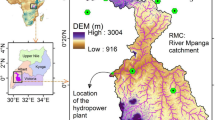Abstract
This study investigates potential changes to hydropower generation using diverse efficiency indexes (EIs) under climate change scenarios of different water year types including “dry” defined as the lower 20 percentile, “normal” as the middle 60 percentile, and “wet” as the upper 20 percentile from the low flow frequency analysis (LFFA) in retrofitting the hydropower description relative to the current conditions. For this study, the multiple linear regression model was fitted to the annual minimum 1 of 7-day average flows with recurrence intervals of 1, 3, 7, 15, or 30 years which were computed using the log-Pearson Type III mathematical technique (LPIII). The climatic impacts’ scenarios results of different water year types’ likelihoods of exceedance give the total annual hydropower as 0.631 MW, 0.550 MW, and 0.392 MW respectively for the lower 20 percentile while the equivalent reservoir inflows result shows an upwards trend in total amounts of runoff, though the patterns of possible changes are both temporally and spatially complex. It is thus important to understand stream and catchment behaviors during the period of limited flow in both natural and under various anthropogenic events. This will provide useful information for long-term river basin management under climate-change conditions which is also necessary for supporting aquatic lives.
Access this chapter
Tax calculation will be finalised at checkout
Purchases are for personal use only
Similar content being viewed by others
References
Jemmali, H.: Water poverty in Africa: a review and synthesis of issues, potentials, and policy implications. Soc. Indic. Res. 136(1), 335–358 (2018)
Brimmo, A.T., Sodiq, A., Sofela, S., Kolo, I.: Sustainable energy development in Nigeria: wind, hydropower, geothermal and nuclear. Renew. Sustain. Energy Rev. 1(74), 474–490 (2017)
Mohammed, A.A., Sule, B.F., Salami, A.W., Adeogun, A.G.: Optimization of energy generation based on operations and ecological integrity requirements. Slovak J. Civ. Eng. 27(3), 55–62 (2019)
Chioma, O., Thomas, S., Hussein, S.U., Aboi, G., Oshiga, O., Ahmed, A.A.: Hydropower generation in Nigeria: impacts and mitigation. In: 2019 15th International Conference on Electronics, Computer, and Computation (ICECCO), pp. 1–5. IEEE (2019)
Okakwu, I.K., Alayande, A.S., Olabode, O.E.: Performance and economic analysis of Kainji hydropower plant in Nigeria. Arid Zone J. Eng. Technol. Environ. 15(2), 461–469 (2019)
Ladokun, L.L., Sule, B.F., Ajao, K.R., Adeogun, A.G.: Resource assessment and feasibility study for the generation of hydrokinetic power in the tailwaters of selected hydropower stations in Nigeria. Water Sci. 32(2), 338–354 (2018)
Sule, B.F., Mohammed, A.A., Salami, A.W.: Artificial neural network (ANN) modeling of reservoir operation at Kainji hydropower dam, Nigeria. In: Proceedings of Science and Information Conference, pp. 189–198. Springer, Cham (2018)
Guzha, A.C., Rufino, M.C., Okoth, S., Jacobs, S., Nóbrega, R.L.B.: Impacts of land use and land cover change on surface runoff, discharge, and low flows: evidence from East Africa. J. Hydrol. Reg. Stud. 15, 49–67 (2018)
Dorber, M., May, R., Veronese, F.: Modeling net land occupation of hydropower reservoirs in Norway for use in life cycle assessment. Environ. Sci. Technol. 52(4), 2375–2384 (2018)
Fuso Nerini, F., Tomei, J., To, L.S., et al.: Mapping synergies and trade-offs between energy and the Sustainable Development Goals. Nat. Energy 3(1), 10–15 (2018). https://doi.org/10.1038/s41560-017-0036-5
Oyerinde, G.: Climate change in the Niger basin on hydrological properties and functions of Kainji Lake, West Africa. Doctoral dissertation, Ph.D. dissertation, Université d’Abomey-Calavi (2016)
Rougé, C., Tilmant, A., Zaitchik, B., Dezfuli, A., Salman, M.: Identifying key water resource vulnerabilities in data-scarce transboundary river basins. Water Resour. Res. 54(8), 5264–5281 (2018)
Ryu, J.H., Lee, J.H., Jeong, S., Park, S.K., Han, K.: The impacts of climate change on local hydrology and low flow frequency in the Geum River Basin, Korea. Hydrol. Process. 25(22), 3437–3447 (2011)
Gibon, T., Arvesen, A., Hertwich, E.G.: Life cycle assessment demonstrate environmental co-benefits and trade-offs of low-carbon electricity supply options. Renew. Sustain. Energy Rev. 76, 1283–1290 (2017)
Hansen, C., McDonald, S., Nabors, A., Shiva, J.S.: Using the national water model forecasts to plan for and manage ecological flow and low-flow during drought. National Water Center Innovators Program Summer Institute report 2017, pp. 66–74 (2017)
Kormos, P.R., Luce, C.H., Wenger, S.J., Berghuijs, W.R.: Trends and sensitivities of low streamflow extremes to discharge timing and magnitude in Pacific Northwest mountain streams. Water Resour. Res. 52(7), 4990–5007 (2016)
Smakhtin, V.: Taking into account environmental water requirements in global-scale water resources assessments, vol. 2. International Water Management Institute (2004)
Stedinger, J.R.: Flood frequency analysis and statistical estimation of flood risk. Inland flood hazards: human, riparian and aquatic communities, pp. 334–358 (2000)
Vogel, R.M., Kroll, C.N.: Low-flow frequency analysis using probability-plot correlation coefficients. J. Water Resour. Plan. Manag. 115(3), 338–357 (1989)
Smakhtin, V.U.: Estimating continuous monthly baseflow time series and their possible applications in the context of the ecological reserve. Water SA 27(2), 213–218 (2001)
Acknowledgment
The financial support from the National Research Foundation (NRF), South Africa to the Risk and Vulnerable Research Centre2: UID Grants - 103232 is well appreciated.
Author information
Authors and Affiliations
Corresponding author
Editor information
Editors and Affiliations
Rights and permissions
Copyright information
© 2021 The Author(s), under exclusive license to Springer Nature Switzerland AG
About this paper
Cite this paper
Amoo, O.T., Nakin, M.D.V., Abayomi, A., Umoh, U., Mutanga, M.B., Bilewu, S.O. (2021). Assessing Impacts of Low Flow on Kainji Hydro-Power Generation. In: Abraham, A., Hanne, T., Castillo, O., Gandhi, N., Nogueira Rios, T., Hong, TP. (eds) Hybrid Intelligent Systems. HIS 2020. Advances in Intelligent Systems and Computing, vol 1375. Springer, Cham. https://doi.org/10.1007/978-3-030-73050-5_78
Download citation
DOI: https://doi.org/10.1007/978-3-030-73050-5_78
Published:
Publisher Name: Springer, Cham
Print ISBN: 978-3-030-73049-9
Online ISBN: 978-3-030-73050-5
eBook Packages: Intelligent Technologies and RoboticsIntelligent Technologies and Robotics (R0)




